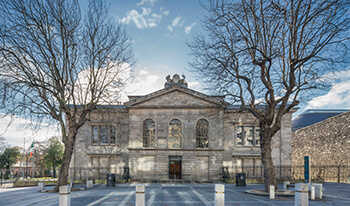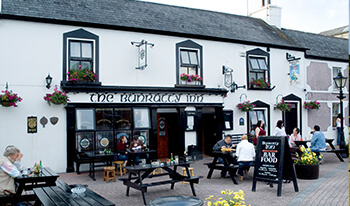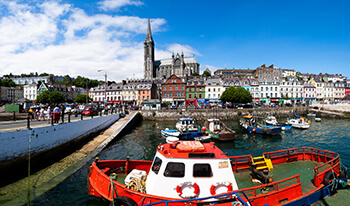The Hook Lighthouse (also know as Hook Head Lighthouse) is situated at the tip of the Hook Peninsula in County Wexford, in Ireland, is one of the oldest lighthouses in the world. Operated by the Commissioners of Irish Lights, the Irish Lighthouse Authority, the Hook marks the eastern entrance to Waterford Harbour
History The existing tower dates from the twelfth century, though tradition states that Dubhan, a missionary to the Wexford area, established some sort of beacon as early as the 5th century. The exact circumstance of the initial construction on the present structure are the subject of some controversy. It had been thought that the tower was constructed in 1172 by Raymond LeGros as part of his conquests in Ireland, both to establish the lighthouse and to serve as a fortress on the approaches to Waterford. More recent studies, however, have attributed construction to William Marshal in 1245. In any case, this tower, in its original form, was 18m high and roughly 8.5m in diameter, with an open fire at the top serving as the beacon. The tower and its grounds was entrusted to the monks, who by then were associated with the Priory of Saint Augustine in Ross. This arrangement continued even through the dissolution of the monasteries under Henry VIII.
Maintenance of the beacon was interrupted by the English Civil War, when the monks abandoned the area. The lack of the light was felt, and in 1657 the governor of Duncannon Fort was petitioned to restore the beacon, but without success. However, in 1665 Charles II authorized Richard Reading to build six lighthouses on the Irish coast, including the rehabilitation of the light at Hook Head. By this time the tower had been enlarged; an addition incorporating a spiral staircase had been added surrounding the old tower, and the height of the whole structure raised to 24m. What Reading did in relighting the beacon is unclear, but he may have constructed an enclosed lantern to shelter the fire, as was customary at the time. The light was returned to service in 1667 and has remained active in some form ever since.
In 1704 Anne transferred custody of the Irish lights to the Revenue Commissioners, but this transfer did not immediately affect Hook Head, as it was held in lease by Henry Loftus of Loftus Hall. The lease passed to his son, who threatened to extinguish the light failing renewal of the lease on his terms. In the end he got his renewal, but at terms more favorable to the crown.
By the 1790s the tower was in need of repair. At this time Thomas Rogers was contracted with to maintain this and nine other lighthouses. He replaced the Reading lantern with a new one housing the Argand lamp and reflector system typical of the period. The beacon was altered in 1812 and then replaced in 1864 with a dioptric lens housed in a new lantern, which is that used today.
Subsequent changes left the structure largely unaltered but updated the light source. Coal gas replaced oil lamps in 1871, with vaporized paraffin taking over in 1911, and electricity in 1972. A rotating third-order Fresnel lens was also installed in 1911. A variety of fog signals were installed beginning with a bell in 1838, a cannon in 1872, an explosive charge in 1905 (altered in 1938), an air horn in 1975, and an electric horn from 1995 on. Resident keeper households were replaced by a team of six keepers in 1977, and the light was automated in 1996. The light continues to operate as an active aid to navigation. An older daymark of three red bands on a white background was altered to two black bands on white in 1938.
In 2001 the light was opened to the public as a tourist attraction after construction of an attached visitors center.
Tours featuring this attraction
Peace of Mind Guarantee
Your trip, worry free!Our Ireland based team is on call throughout your vacation!




